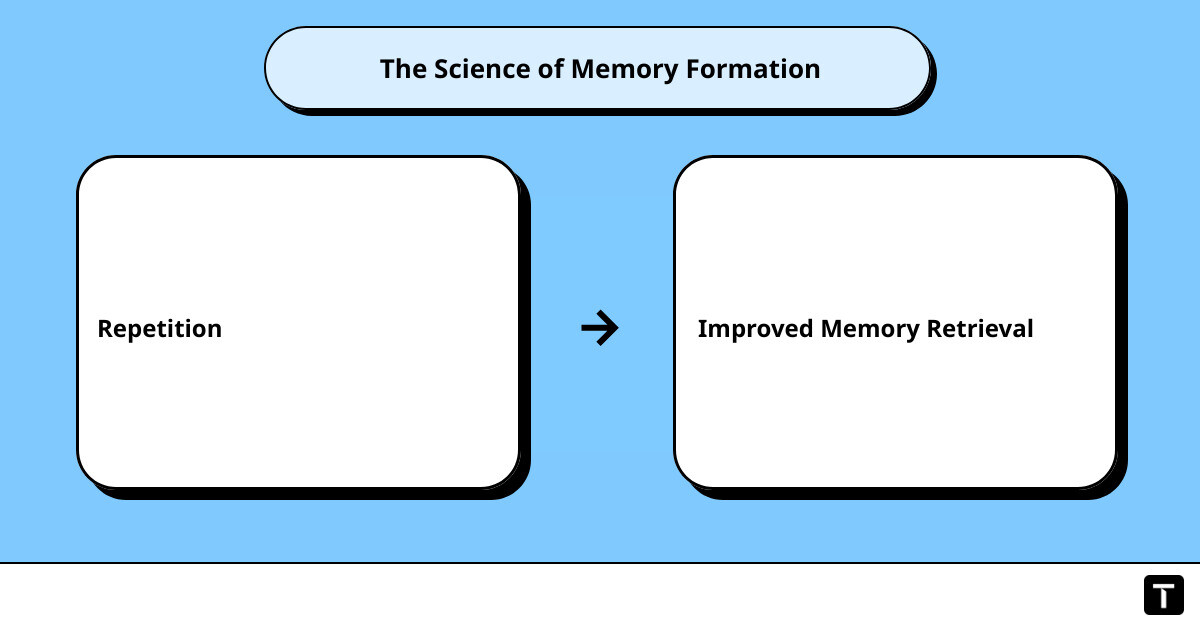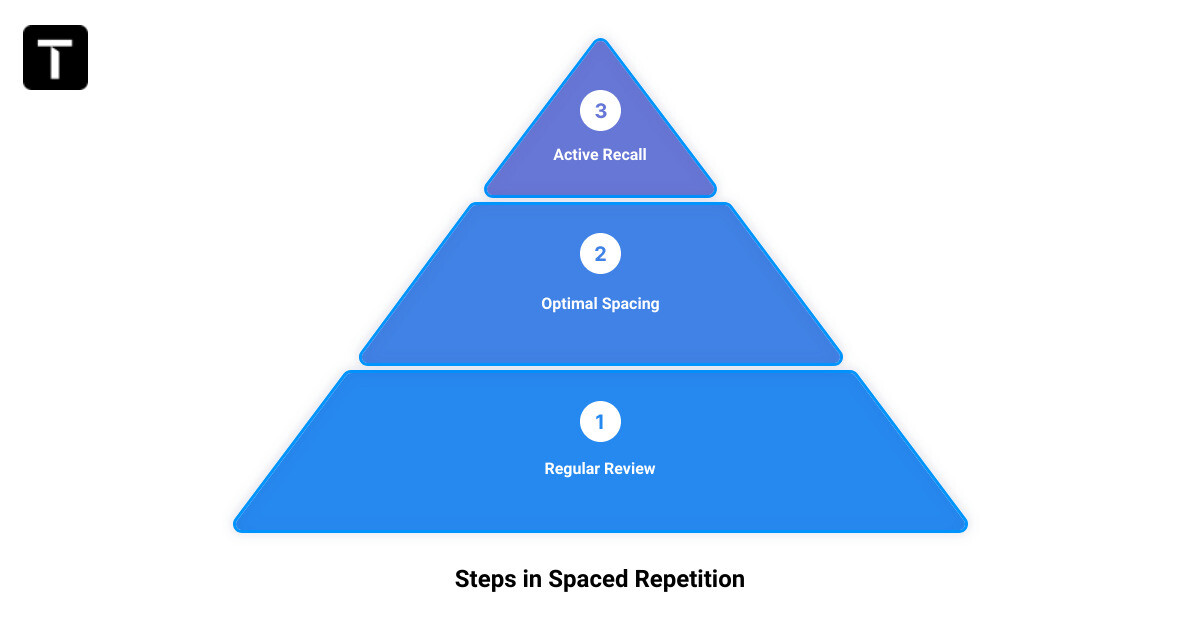Unlock the power of your memory! Welcome to our deep dive into the repetition memory strategy, an evidence-based learning technique that's all about making your studies smarter, not harder. If you're passionate about lifelong learning and looking for the most efficient ways to absorb and retain information, you're in the right place. Especially if you're on the fascinating journey of learning Mandarin, including the myriad of Chinese characters, this guide is for you.
The repetition memory strategy, also known as spaced repetition, is not a new concept. It is a scientifically-proven method that leverages the way our brain forms and strengthens neural connections when we repeat a task or review information at specific intervals. This strategy is based on the spacing effect, a memory phenomenon that suggests our brains learn more effectively when we space out our learning over time.
Not only does the repetition memory strategy help us remember information longer, but it also makes the learning process more efficient and effective. By understanding and implementing this method, you can turbocharge your memory, optimize your learning, and master any subject you're passionate about, including Mandarin.
In the upcoming sections, we will dissect the science behind repetition memory strategy, learn about its practical application, and explore how technology, like Traverse, can make it easier to implement this strategy in your learning routine. Whether you're a beginner or a seasoned learner, this guide will help you decode and harness the power of the repetition memory strategy. Stay tuned, and take the first step towards making your learning unforgettable!

The Science Behind Repetition Memory Strategy
Embarking on the road to mastering any subject, including Mandarin, requires not just passion but also an understanding of the cognitive mechanisms that underpin effective learning. One such key mechanism is the repetition memory strategy, a scientifically validated technique to boost memory retention. Let's delve into the underlying science of this potent strategy.
The Role of Repetition in Memory Formation
The crux of the repetition memory strategy lies in the belief that "repetition is a well-documented trigger for memory formation." As Nikolay V. Kukushkin from New York University explains, the more times something is repeated, the better it is remembered. In essence, the act of repeating information embeds it deeper into our memory, enhancing our ability to recall it later. This principle is incredibly beneficial when tackling intricate subjects like learning Mandarin or mastering Chinese characters, where repetition can cement the new information in your memory.
The Spacing Effect: The Key to Effective Repetition
However, repetition alone isn't enough. The timing of these repetitions is equally crucial. This is where the 'spacing effect' comes into play, a concept first explored by psychologist Hermann Ebbinghaus in the late 1880s. The spacing effect indicates that our brains absorb information more effectively when we space out our learning over time. It's like building a brick wall; if you stack the bricks too quickly without allowing the mortar to solidify, you'll end up with a shaky structure. Similarly, allowing time between your learning sessions lets your mental 'mortar', or memory, solidify, leading to more robust retention. In essence, the spacing effect is the secret sauce that makes the repetition memory strategy so effective.
Storage Strength vs Retrieval Strength: The Dual Nature of Memory
At the heart of the repetition memory strategy lies an understanding of the dual nature of memory: storage strength and retrieval strength. Storage strength refers to the stability of a memory in our brain. Once our brain deems a piece of information important enough to store, it stays there. However, retrieval strength, which concerns our ability to access this stored memory, can fade over time, necessitating regular maintenance.
So, when we talk about 'forgetting' something, it's more about accessibility than loss. The memory still exists in storage, but we may struggle to find it. Regular review and retrieval, a cornerstone of the repetition memory strategy, help maintain our ability to recall critical information, making it a potent weapon in your learning arsenal.
By understanding these principles, you're well-equipped to reap the maximum benefits of the repetition memory strategy, be it for learning Mandarin, mastering Chinese characters, or any other learning endeavor.

Practical Application of Repetition Memory Strategy
The science behind repetition memory strategy is fascinating, but what does it look like in practice? How can you, a lifelong learner, apply these cognitive principles to your Mandarin studies or any other learning journey? It's time to take the theoretical knowledge and translate it into concrete, actionable steps. Let's dive into the practical application of the repetition memory strategy.
The Leitner System: A Simple Approach to Spaced Repetition
The Leitner System, developed by Sebastian Leitner, is a tried-and-true method that leverages the power of spaced repetition. This system involves creating a set of flashcards and sorting them into boxes based on how well you know the information. The crux of the Leitner System is this: if you answer a flashcard correctly, it moves to the next box with a longer review interval. If you answer incorrectly, it goes back to the first box for more frequent reviews. This strategic approach ensures that you review challenging information more often, effectively boosting your learning efficiency.
Optimal Time Intervals for Spaced Repetition
The “spacing” in spaced repetition refers to the gaps of time between your study sessions. The timing of these intervals is crucial to optimize your retention and recall. Research suggests that the most effective schedule for spaced repetition is to review the material 24 hours after the initial learning session, then a week later, followed by two weeks, a month, two months, five months, and finally a year later. However, these intervals are not one-size-fits-all. They might need to be adjusted based on factors such as your familiarity with the material, the complexity of the information, and your personal learning pace.
The Power of Active Recall in Spaced Repetition
Active recall is the cornerstone of the repetition memory strategy. It's not just about rote memorization, but involves retrieving information from memory, which strengthens the neural pathways associated with that information. Flashcards are a simple yet effective tool for facilitating active recall. By using flashcards, you're not just passively reading the information, but actively recalling it, which enhances your learning and helps you answer more questions correctly. Plus, the use of the Leitner System with flashcards ensures that you're reviewing and recalling information at optimal spacing intervals, which further boosts your recall and retention.
Applying the repetition memory strategy to your studies does not only help you retain information but also deepens your understanding of the material. With the Leitner System, optimal time intervals, and active recall, you're well on your way to mastering Mandarin or any other learning endeavor.
Repetition Memory Strategy in Action: Case Studies
Now that we've delved into the science and application of the repetition memory strategy, let's examine how this method works in real-life scenarios. From vocabulary acquisition to multiplication problems and memorizing names, the power of repetition memory strategy knows no bounds.
Spaced Repetition for Learning Vocabulary Words
Imagine you're embarking on the journey to learn Mandarin, a language with thousands of unique characters. The repetition memory strategy can be a game-changer here. After you first learn a character like "你" (meaning "you"), the strategy will schedule it for review in a day. Successfully recalling it will extend the review interval to three days, then seven days, and so on. Each successful review further imprints the character into your long-term memory, making the process of vocabulary acquisition a breeze.
Spaced Repetition for Memorizing Multiplication Problems
Mathematics can be a daunting field, especially when it comes to memorizing multiplication tables or complex formulas. But with the repetition memory strategy, you can conquer this challenge. By reviewing these problems just before they're about to fade from memory, you not only reset the forgetting curve to 100% but also slow down its decay. This means that the time interval for the next repetition increases, flattening the forgetting curve and enabling longer retention of the information.
Spaced Repetition for Remembering Names
Ever found yourself in an awkward situation forgetting someone's name after just meeting them? The repetition memory strategy can come to your rescue. Let's say you meet someone named "John". To remember his name, you might want to repeat it 30 times, creating a mnemonic. This active recall will help you remember John's name more effectively. The more you repeat the name at spaced intervals, the stronger your memory of it becomes.
In conclusion, the repetition memory strategy, when applied effectively, can supercharge your learning and memory recall in different domains. Whether it's learning Mandarin characters, mastering multiplication problems, or simply remembering names, this strategy can significantly enhance your retention and recall. It's the science-backed secret to unlocking the full potential of your memory.
Leveraging Technology for Repetition Memory Strategy
In the digital age, we are fortunate to have technology at our fingertips that can assist us in implementing the repetition memory strategy effectively. Software like Traverse, an advanced self-learning app, is designed to integrate the best learning strategies, including the power of spaced repetition, with technology to make your learning journey more efficient and enjoyable.
Using Traverse for Effective Spaced Repetition
Traverse takes the concept of spaced repetition and propels it to the next level. It's not just about repeating and reviewing information, but also about how it's done. Traverse encourages active recall, a critical component of the repetition memory strategy, by reviewing information at optimally spaced intervals. This approach helps you to keep the material fresh in your mind, reinforcing your memory recall in the process. More importantly, Traverse adapts to your individual needs and goals, providing a personalized learning experience that evolves with you.
Importing Anki Decks into Traverse for Continued Learning
For those who have been using Anki, a popular flashcard program that uses spaced repetition, Traverse offers a seamless transition. You can easily import your Anki decks into Traverse, allowing you to continue your learning journey without any disruptions. This feature ensures that you can leverage the powerful learning strategy of spaced repetition, no matter which platform you started with.
Mandarin Learning with Traverse and Mandarin Blueprint
If you are a lifelong learner striving to master Mandarin, Traverse, in partnership with Mandarin Blueprint, provides a tailored experience designed to make mastering Chinese characters a breeze. The repetition memory strategy is uniquely effective in tackling the complexities of Mandarin. By repeating and reviewing Mandarin characters at increasing intervals, you are effectively training your brain to store this information in your long-term memory.
With these strategies and tools at your disposal, you're not just studying smarter—you're unlocking your true learning potential. Embrace the power of spaced repetition. Take control of your learning journey. And remember—every giant leap forward begins with a single step. Your first step? Implementing spaced repetition with Traverse today.
Conclusion: Maximizing Learning with Repetition Memory Strategy
As we wrap up this exploration into the world of the repetition memory strategy, let's underscore the fact that mastering any subject, including Mandarin, doesn't happen overnight. It's a process that requires time, effort, and the right methodology. Understanding the science behind memory formation and leveraging the power of spaced repetition can revolutionize your learning process, making it more efficient and effective.
The fascinating interplay between repetition, spacing, and active recall not only makes learning more manageable but also ensures that the knowledge you gain will stay with you for a long time. The cognitive science principles such as the spacing effect and the forgetting curve, when harnessed appropriately, can drastically improve your memory retention.
Practical application of these principles can be made easier with the help of technology. Tools like Traverse provide a streamlined platform for implementing the repetition memory strategy, allowing you to create effective flashcards, test yourself, and schedule your reviews at regular intervals. Importing Anki decks into Traverse or using the Mandarin Blueprint can further enhance your Mandarin learning experience.
To put it simply, the repetition memory strategy is not just about rote learning or mindless repetition. It's about understanding how your brain works and using that knowledge to your advantage. It's about learning smartly, retaining effectively, and achieving your learning goals more efficiently.
So, as a lifelong learner, take this opportunity to embrace the repetition memory strategy. Use it to take your learning to new heights. Whether you're learning Mandarin characters or trying to master complex algorithms, remember that with the right approach, the sky's the limit.
Unleash the power of the repetition memory strategy today and experience the difference it can make in your learning journey. Happy learning!

